This document covers the following topics:
For general information on how to manage objects (for example, how to add or copy an object), see the Predict Object Description documentation.
When you add a dataspace, you first have to specify the dataspace type in the New Predict Object dialog box.
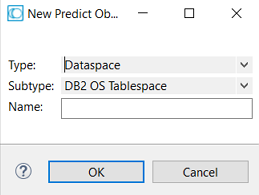
When you choose the button, a dataspace type-specific window appears. The dataspace type is indicated in the title bar.
The following window applies to DB2 mainframe dataspaces.
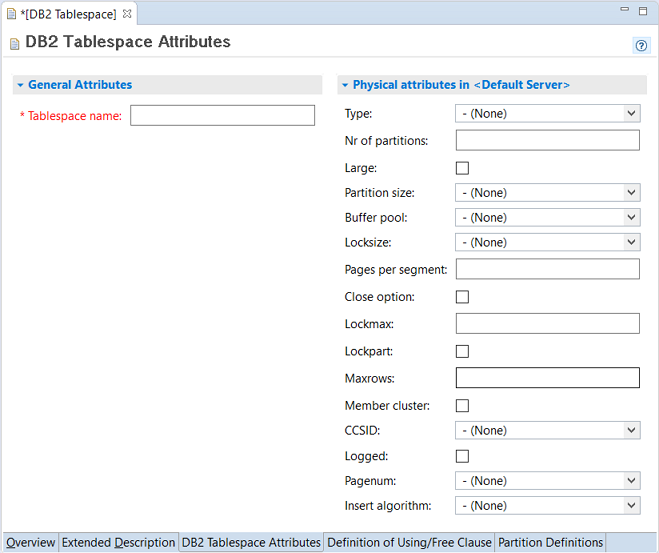
| Parameters | ||
|---|---|---|
| Tablespace name | Name of the table space in DB2. | |
| Type | Table space type. | |
| S | Segmented. | |
| P | Partitioned. | |
| R | Range partitioned. | |
| G | Partition by growth. | |
| ' ' | Simple. This is the default setting. | |
| Nr of partitions |
Number of partitions used by the table space
(corresponding to the Maximum number of partitions used by the table space
(corresponding to the Partitions can be defined Partitions can be defined explicitly or with default values (see Using/free clause below) if table space type is either P or R. Partition definitions are used when generating table spaces from Predict dataspace objects. |
|
| Large | Identifies a table space as large. | |
| Y | Yes. | |
| N | No. | |
| Buffer pool | Name of the buffer pool to be associated with the table space. | |
| Partition size | Only valid for partitioned tablespaces. | |
| Locksize | Locking level for the table space. Valid values: | |
| A | Any level locking. | |
| P | Page level locking. | |
| R | Row level locking. | |
| S | Table space level locking. | |
| T | Table level locking (only valid for segmented DS). | |
| Pages per segment |
How many pages are to be assigned to each segment (parameter SEGSIZE) for table space type S, G or R. Pages per segment must be zero for table space type ' ' (Simple) or P. |
|
| Logged | blank | Not specified. This is the default setting. |
| Y | Yes. | |
| N | No. | |
| Pagenum | Specifies the type of page numbering that is used when you alter a partition-by-range table space. | |
| ' ' | None. This is the default setting. | |
| R | Relative. | |
| A | Absolute. | |
| Insert algorithm | Specifies the algorithm that is used when rows are inserted into tables in this table space. | |
| ' ' | None. This is the default setting. | |
| 1 | Level 1. | |
| 2 | Level 2. | |
| Close option | Y | The data sets which support the table space are closed when nobody is using the table space. |
| Lockmax | The maximum number of pages or row locks an application can hold simultaneously in the table space. Valid values: | |
| blank | ||
| SYSTEM | ||
| 0 - 2,147,483,647. | ||
| If parameter Locksize is set to S or T, Lockmax must be set to 0. | ||
| Lockpart | Partition locking. Valid values: | |
| blank | not specified. | |
| Y | Yes. | |
| N | No. | |
| Maxrows | The maximum number of rows. | |
| CCSID | Encoding scheme. Valid values: | |
| blank | not specified. | |
| A | ASCII. | |
| E | EBCDIC. | |
| U | Unicode. | |
| Member cluster | Specifies that data inserted by the INSERT statement is not clustered by the implicit clustering index (the first index) or the explicit clustering index. Instead, DB2 chooses where to locate the data in the table space based on available space. Valid values: | |
| blank | not specified. | |
| Y | Yes. | |
| N | No. | |
The values specified in the Definition of using/free clause tab are used as default values.
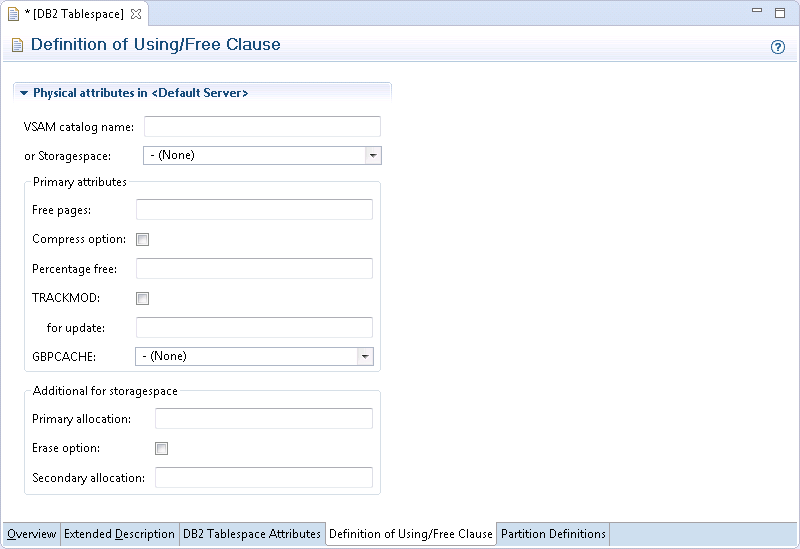
| Parameters | |||||||||||||
|---|---|---|---|---|---|---|---|---|---|---|---|---|---|
| VSAM catalog name | Name of the VSAM catalog containing an entry for the data sets of the table space. Must not be specified if the parameter Storagespace is specified. | ||||||||||||
| Storagespace | Name of the storagespace for the table space documented with the Predict Dataspace object. Must not be specified if the parameter VSAM catalog is specified. | ||||||||||||
| Primary attributes | |||||||||||||
| Free pages | How often pages are to be left free when loading or reorganizing table spaces or partitions. Max. value is 255. Default is 0, leaving no free pages. | ||||||||||||
| Percentage free | Percentage of each page to be left free. Equivalent in DB2 is the PCTFREE option. | ||||||||||||
| for update |
Percentage of each page that is reserved to be used only by future update operations. Equivalent in DB2 is the PCTFREE FOR UPDATE option. When you specify -1, DB2 uses real-time statistics to automatically calculate how much free space to reserve for updates. This is the default. |
||||||||||||
| Compress option |
|
||||||||||||
| GBPCACHE |
|
||||||||||||
| TRACKMOD |
|
||||||||||||
| Additional for storagespace | |||||||||||||
| Primary allocation | Primary space allocation for DB2 defined data sets. | ||||||||||||
| Secondary allocation | Secondary space allocation for DB2 defined data sets. | ||||||||||||
| Erase option |
|
||||||||||||
Each individual partition can be defined in the Definition of partitioned dataspace tab. The maximum number of partitions is 4096.
To define a new partition, use the button. When you have defined more than one partition, a scroll bar is available. To go to a specific partition, use the scroll bar. To delete the currently displayed partition, choose the button.

| Parameters | |
|---|---|
| DSSIZE | Specifies the maximum size (in Gbyte) for each partition of a partitioned index. |
| For all other values/options see previous table above for a description of the parameters. | |
The following window applies to SQL/DS dataspaces.
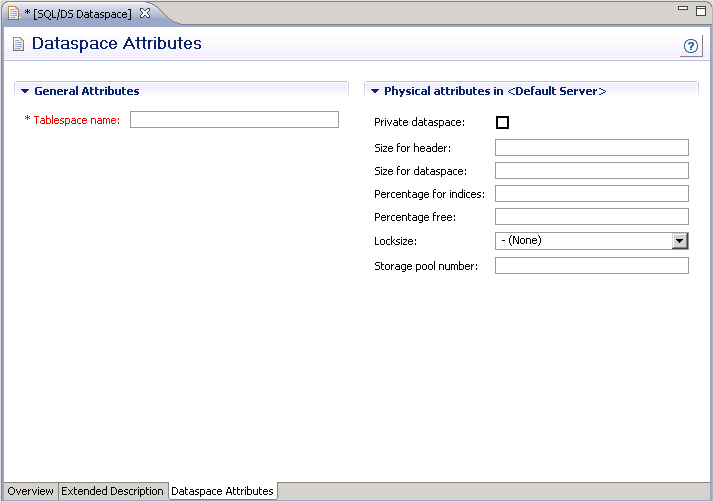
| Parameters | |||||||||||||
|---|---|---|---|---|---|---|---|---|---|---|---|---|---|
| Tablespace name | Identifier of the table space and name of the DBspace in SQL/DS. | ||||||||||||
| Private dataspace |
|
||||||||||||
| Size for header | Number of 4096-byte logical pages reserved for header. | ||||||||||||
| Size for dataspace | Size reserved for the dataspace. | ||||||||||||
| Percentage for indices | Percentage of the reserved space that can be used for indexes. | ||||||||||||
| Percentage free | Percentage of reserved space to be kept free. | ||||||||||||
| Locksize |
|
||||||||||||
| Storage pool number | Storage pool number. This parameter tells SQL/DS to acquire the dbspace from a specified storage pool. | ||||||||||||
The following window applies to DB2 open systems dataspaces.
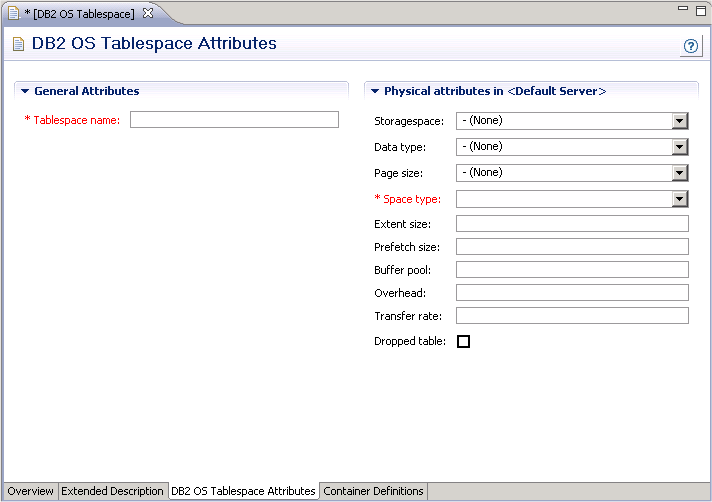
| Parameters | |||||||||||||
|---|---|---|---|---|---|---|---|---|---|---|---|---|---|
| Tablespace name | Name of the tablespace in DB2. | ||||||||||||
| Storagespace | Name of the storagespace for the tablespace documented with the Predict dataspace object. | ||||||||||||
| Data type |
|
||||||||||||
| Page size | Defines the size of pages used for the tablespace. Valid values: 4K, 8K, 16K, 32K, 4096, 8192, 16384, 32768 or not specified. | ||||||||||||
| Space type |
|
||||||||||||
| Extent size | Specifies the number of PAGESIZE pages that will be written to a container before skipping to the next container. Valid values are 0 or integer or integer with unit K, M or G. | ||||||||||||
| Prefetch size | Specifies the number of PAGESIZE pages that will be written to a container before skipping to the next container. Valid values are 0 or integer or integer with unit K, M or G. | ||||||||||||
| Buffer pool | Name of the buffer pool to be associated with the tablespace. | ||||||||||||
| Overhead | Specifies the I/O controller overhead and disk seek and latency time (in milliseconds). | ||||||||||||
| Transfer rate | Specifies the time to read one page into memory (in milliseconds). | ||||||||||||
| Dropped table |
|
||||||||||||
The following window applies when defining containers.
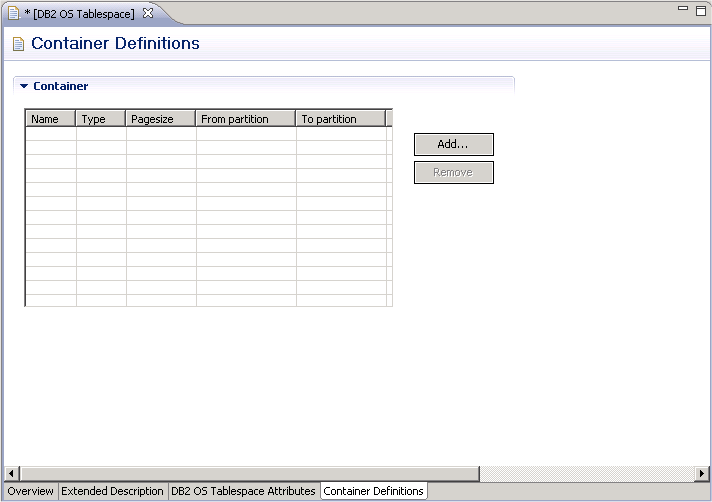
| Parameters | |
|---|---|
| Container number (1, 2, etc.) | Specifies the container for a tablespace. Choose to enter a new container. Use the scrollbar to select an existing container (only applicable if more than one container exists). |
| Partition numbers | Specifies the partition numbers on which the container is created in a partitioned database. |